Want to buy or sell something? Check the classifieds
-
The Fedora Lounge is supported in part by commission earning affiliate links sitewide. Please support us by using them. You may learn more here.
You are using an out of date browser. It may not display this or other websites correctly.
You should upgrade or use an alternative browser.
You should upgrade or use an alternative browser.
Side By Side/ Hat Comparisons
- Thread starter alanfgag
- Start date
splintercellsz
I'll Lock Up
- Messages
- 6,146
- Location
- Somewhere in Time
I'm glad you enjoyed this one. These two are my favorite, so it is an enjoyment handling them againAnother wonderful comparison, Justin. Thank you. Impossible to choose a favourite between the two. Both examples of superb hatmaking.
Sent from my SM-G935P using Tapatalk
splintercellsz
I'll Lock Up
- Messages
- 6,146
- Location
- Somewhere in Time
Anytime!! I have some more comparisons in my head, just need to figure out what hats I wish to use!Amazing hats, and a great comparison. Thanks for posting all of these. The sweats and liners are incredible.
Sent from my SM-G935P using Tapatalk
Daniele Tanto
I'll Lock Up
- Messages
- 4,350
- Location
- Verona - Italia
Pre-1920s Austrian Velours
A. Peschel - Brown
Dunlap - Black
Each of these hats are done in the velour finish. The Felts of each is extremely malleable to the touch, almost as if a breeze will shape the felt. The Peschel has had its sweatband, and ribbon replaced a few years back, while the Dunlap retains its original equipment
Each hat has a Sheen to it when held in the light, which is common on velour finishes. Each hat has been flanged to be worn up brim, which was common when they were created. This is where I will stop my rambling, and let the photos do the talking
The hats in the pictures speak for themselves!c.1900s Stetson Exposition Velour & c.1920s Stetson Clear Nutria Velour "Extra Lightweight"
For your viewing pleasure today, I will be comparing two of my favorite hats. Each hat is a deep black velour finish, with silver felt fibers throughout the Hat. The 1900s example carries an elegant brim curl, whereas the 1920s hat has more of a flatter flange.
Looking at each of the hats ribbons, the 1900s hat has a more squared off bow, whereas the 1920s variant has a little flare towards the rear of the bow.
The crown profile of each hat is fairly similar, straight sides with a flat top, though the earlier hat has a more rounded profile, reminiscent of some early Derbies that I have seen. Be felt on the nutria is extremely soft and if I blow hard enough on the top of the Hat I am able to cause the crown to somewhat slightly bash in.
Looking at the inside construction, each hat is readed, and the sweatbands are attached with the V stitching of the era. Each hat Bears a taped sweatband scene, and both their the circular size sticker. The early exposition has a texturized sweatband, whereas the nutria has an extremely smooth sweatband. The 1900s hat also has a unique liner, which has swirlish type designs which I have tried to photograph.
Looking at you size tags behind the sweatband, the Nutria has the tri-pannel, where is the early has a size sticker that I have not seen in my collection before, only online. Now I will stop my ramblings and let the photos finish talking
Fantastic and wonderful, nothing else to add!
Complimenti Justin!
- Messages
- 17,704
- Location
- Maryland
Justin, Super! I am on travel so not checking the board regularly.
- Messages
- 12,384
- Location
- Albany Oregon
Another great comparison entry Justin. It is interesting how the light is such a friend to a velour. I can only imagine some stylish men standing on the steps of a NY building on a sunny autumn day in these hats, shining.c.1900s Stetson Exposition Velour & c.1920s Stetson Clear Nutria Velour "Extra Lightweight"
For your viewing pleasure today, I will be comparing two of my favorite hats. Each hat is a deep black velour finish, with silver felt fibers throughout the Hat. The 1900s example carries an elegant brim curl, whereas the 1920s hat has more of a flatter flange.
Looking at each of the hats ribbons, the 1900s hat has a more squared off bow, whereas the 1920s variant has a little flare towards the rear of the bow.
The crown profile of each hat is fairly similar, straight sides with a flat top, though the earlier hat has a more rounded profile, reminiscent of some early Derbies that I have seen. Be felt on the nutria is extremely soft and if I blow hard enough on the top of the Hat I am able to cause the crown to somewhat slightly bash in.
Looking at the inside construction, each hat is readed, and the sweatbands are attached with the V stitching of the era. Each hat Bears a taped sweatband scene, and both their the circular size sticker. The early exposition has a texturized sweatband, whereas the nutria has an extremely smooth sweatband. The 1900s hat also has a unique liner, which has swirlish type designs which I have tried to photograph.
Looking at you size tags behind the sweatband, the Nutria has the tri-pannel, where is the early has a size sticker that I have not seen in my collection before, only online. Now I will stop my ramblings and let the photos finish talking










Sent from my SM-G935P using Tapatalk
splintercellsz
I'll Lock Up
- Messages
- 6,146
- Location
- Somewhere in Time
c.1930s & 1940-45 Dobbs Cross Countries
Today, I will be comparing these two examples.
The '30s hat is pale grey with blue/purple undertones depending on lighting, where the '40s De Luxe is grey with what appears to be a slight greenish/blue undertone to the felt.
Side by side, the '40s model seems to be more "blockish" in the crown form, where the '30s has slight reverse taper. From the side, we can see that the 40's has inwards taper, where the '30s maintains a decently straight profile.
The '30s has a raw edge brim treatment, where the '40s has the "Improved Felted Welt Edge", which can be seen in the close up photograph.
The felt to each is extremely smooth to the touch, with the lighter hat being the '30s example (I don't own a scale so I go by the weight in hand). The sweatbands on each are extremely thin, with the '30s being unredded, and the '40s having a reed. The rear seams on the 30s hat is taped, whereas the '40s is stitched together.
Note how hat information labels (behind sweatband) changed within a 10 year span.
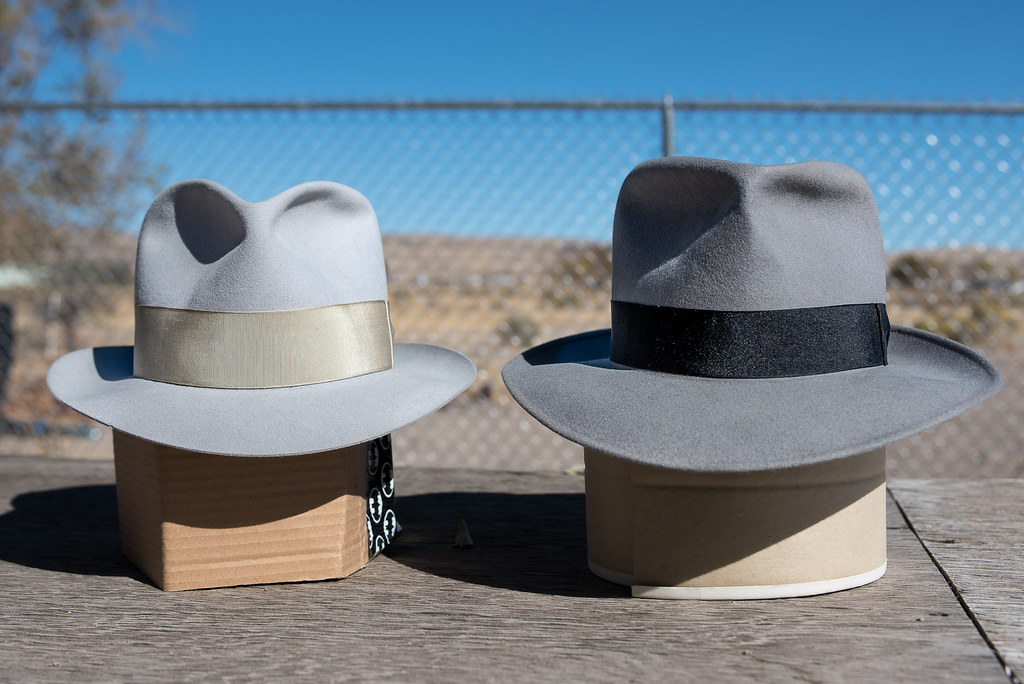
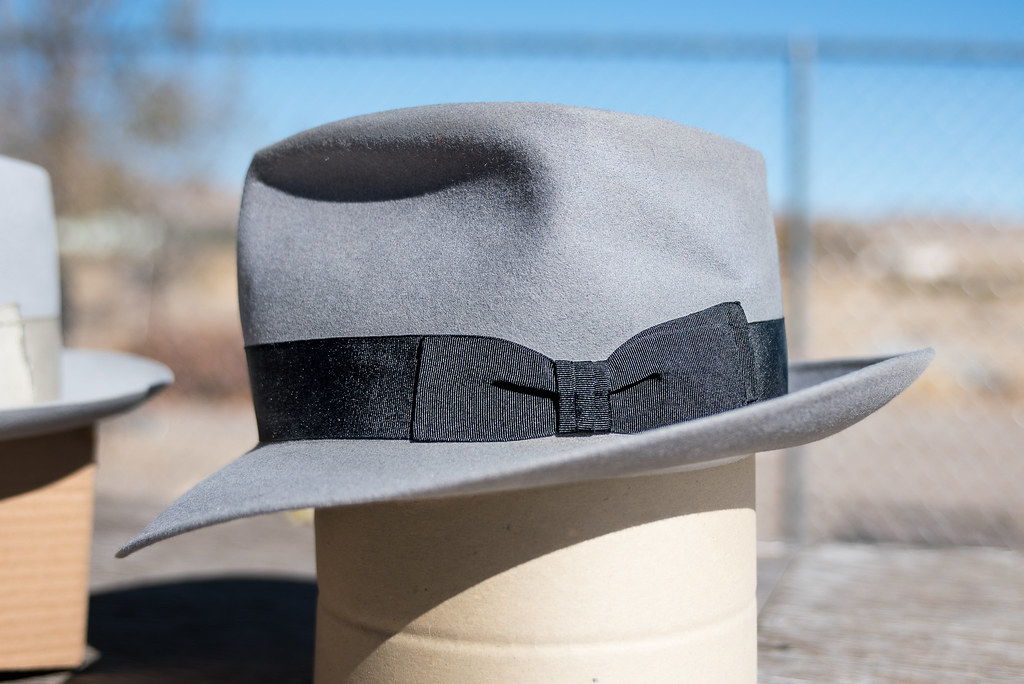
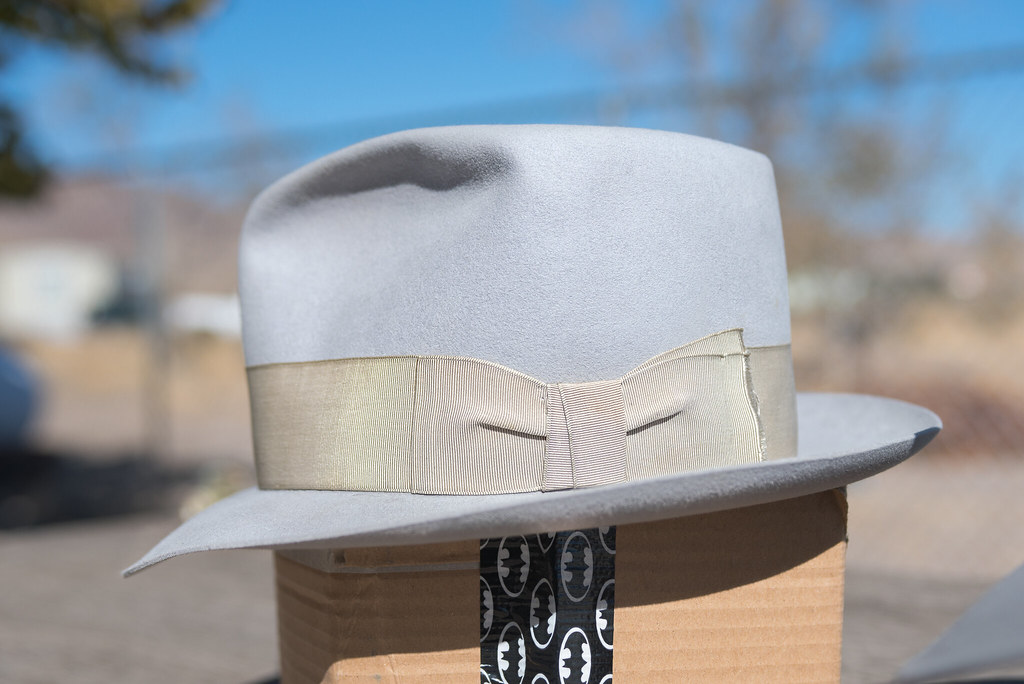
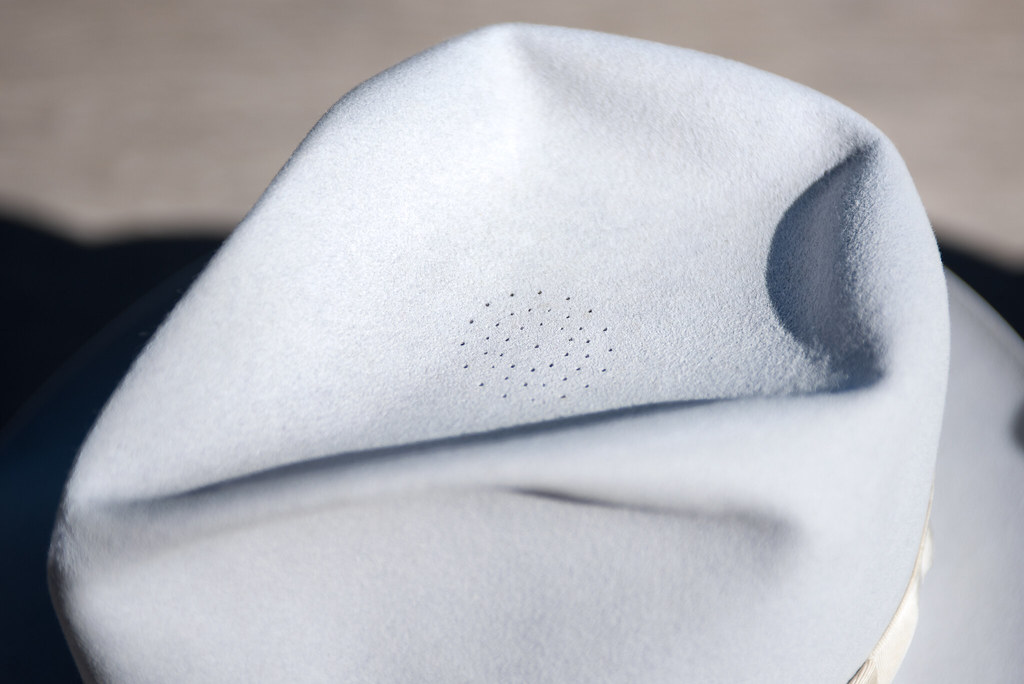
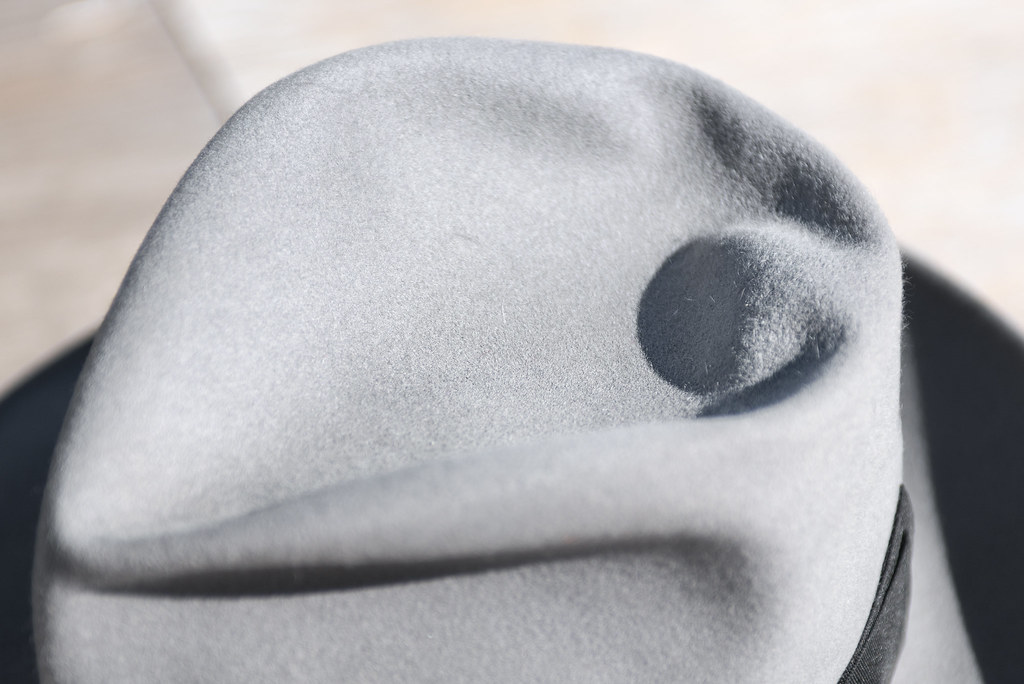
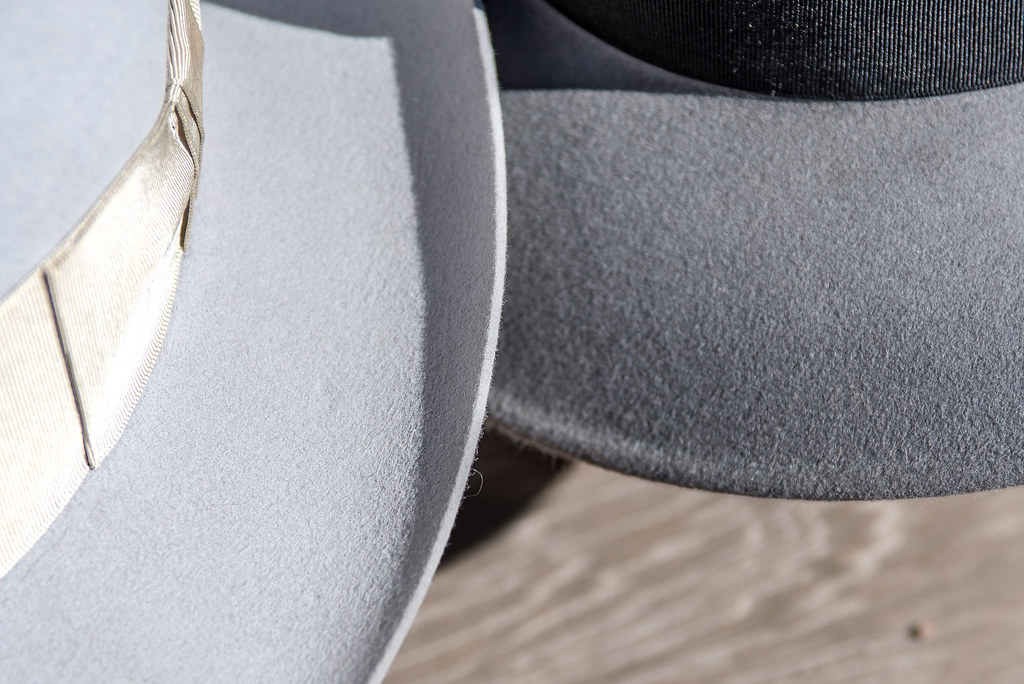
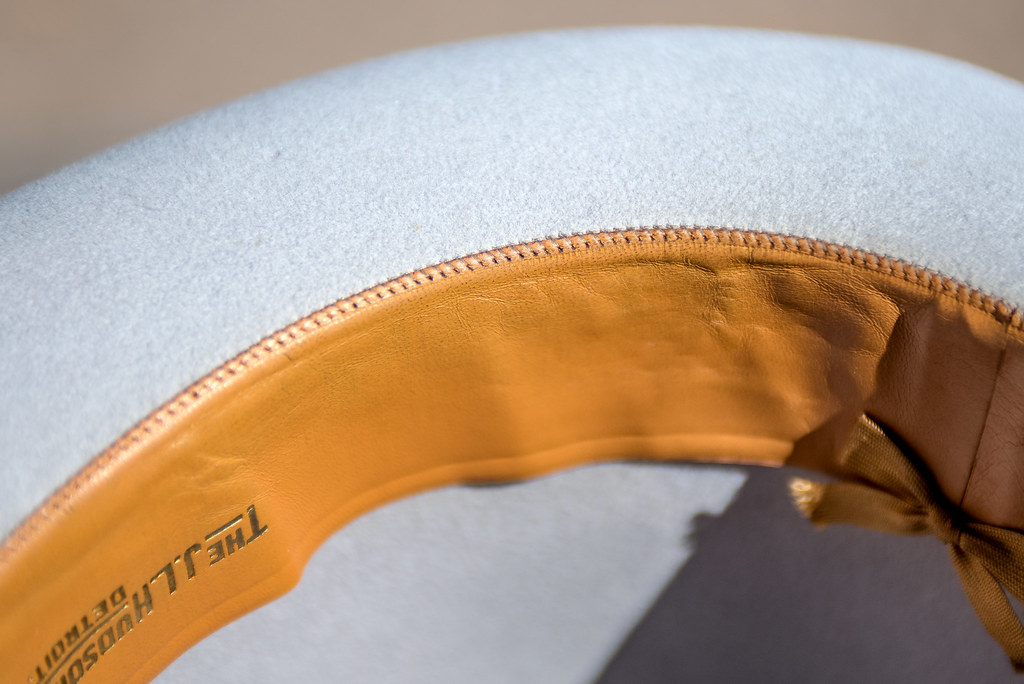
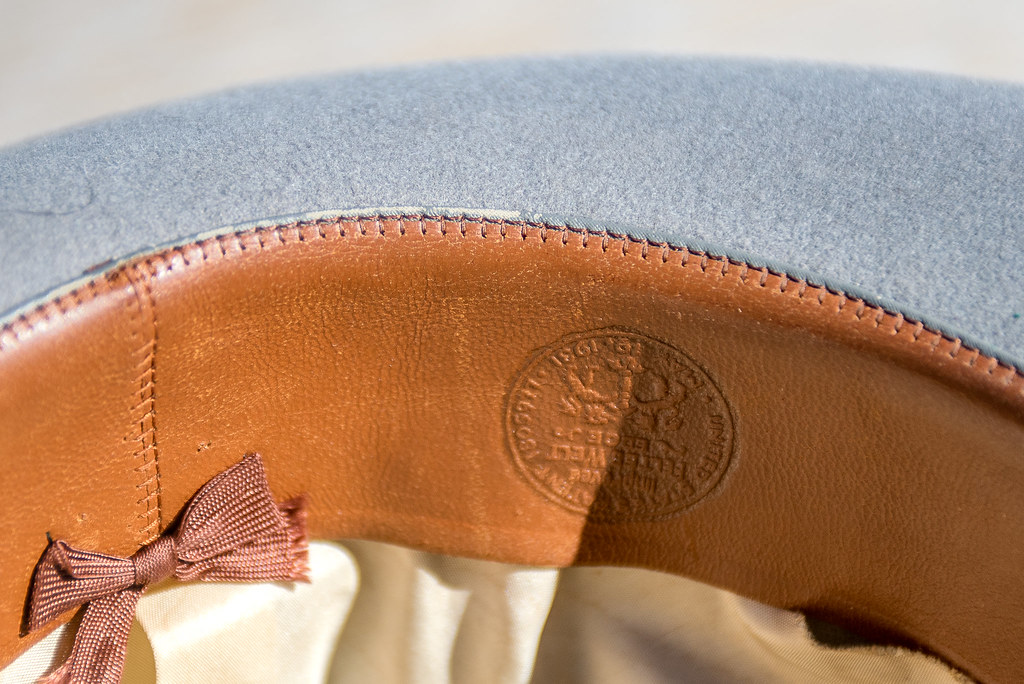
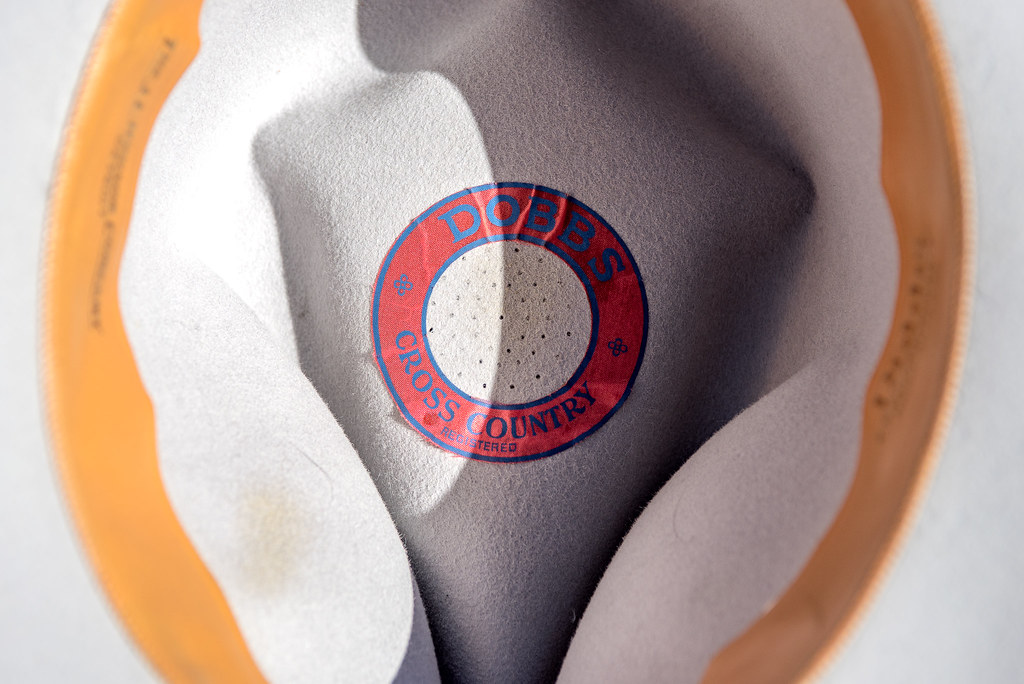
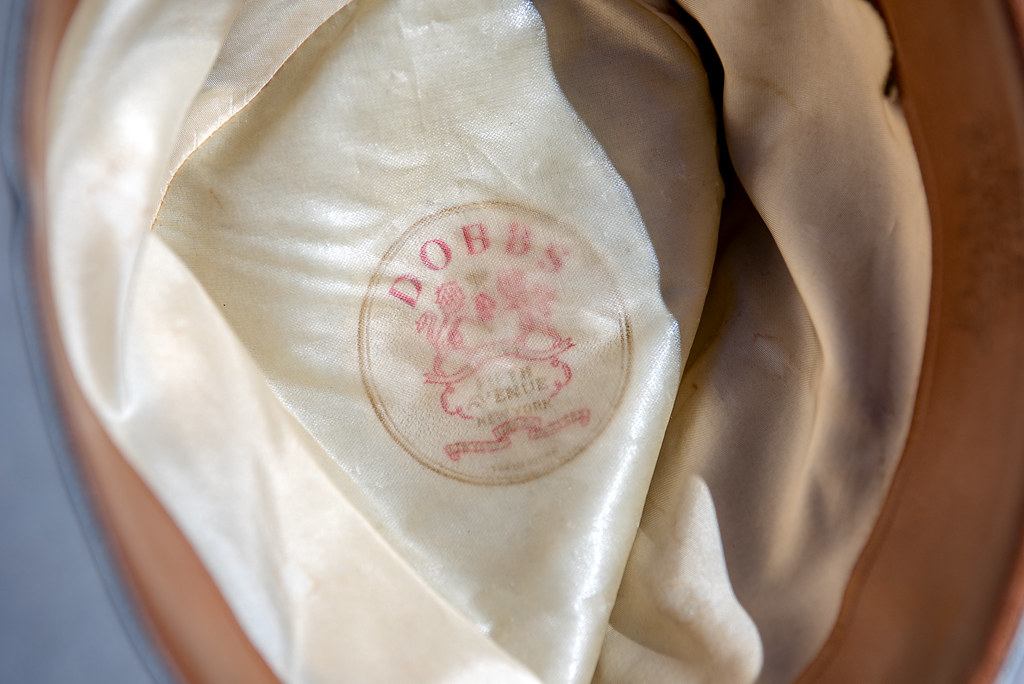
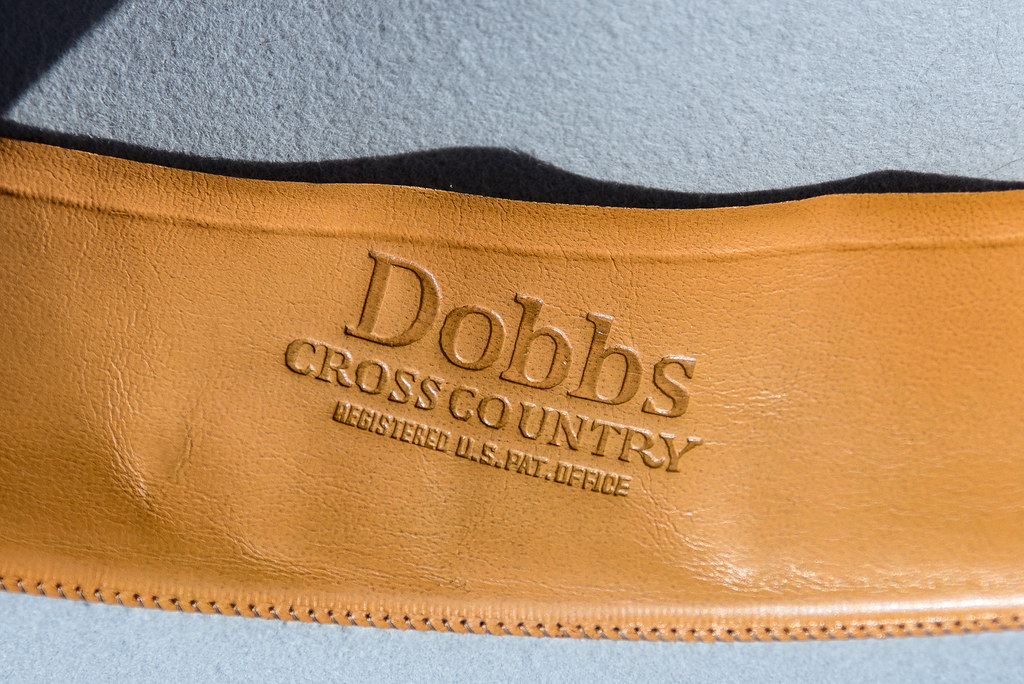
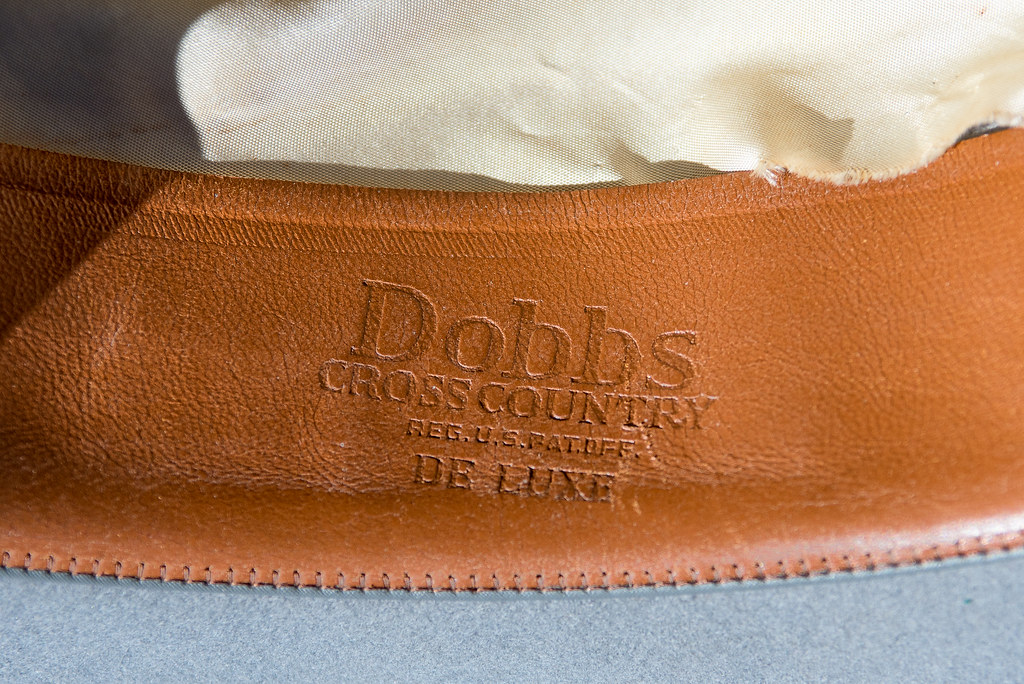
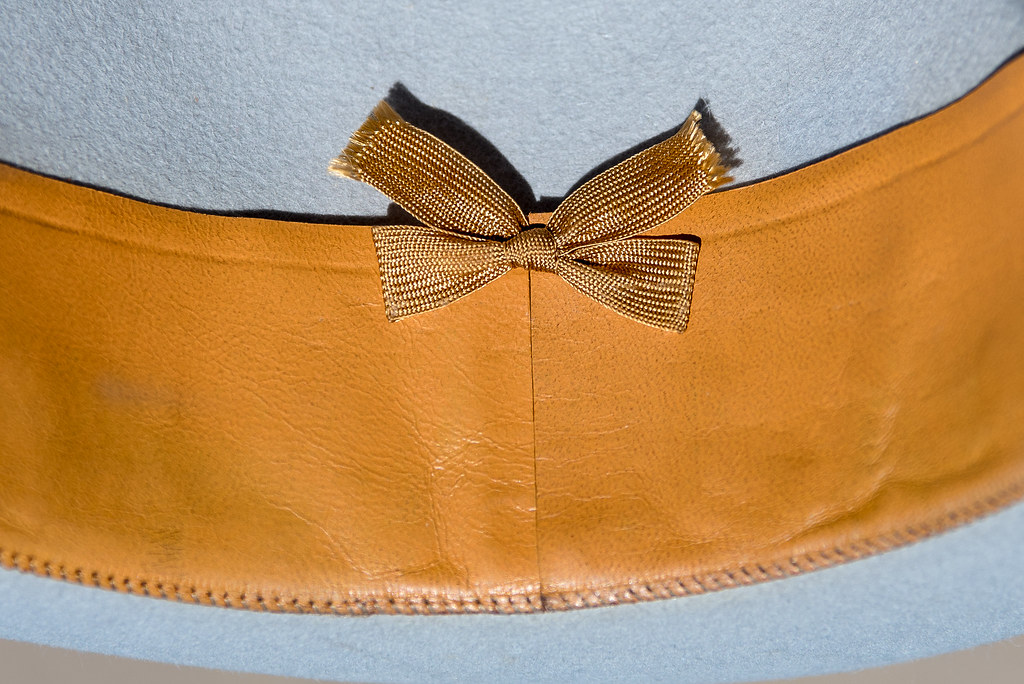
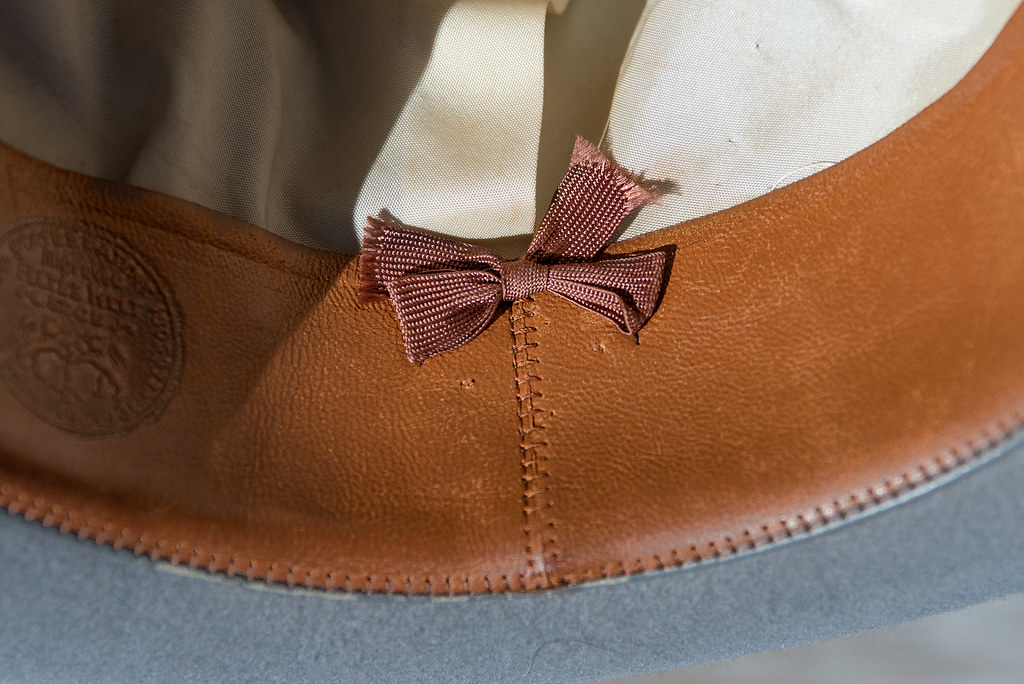
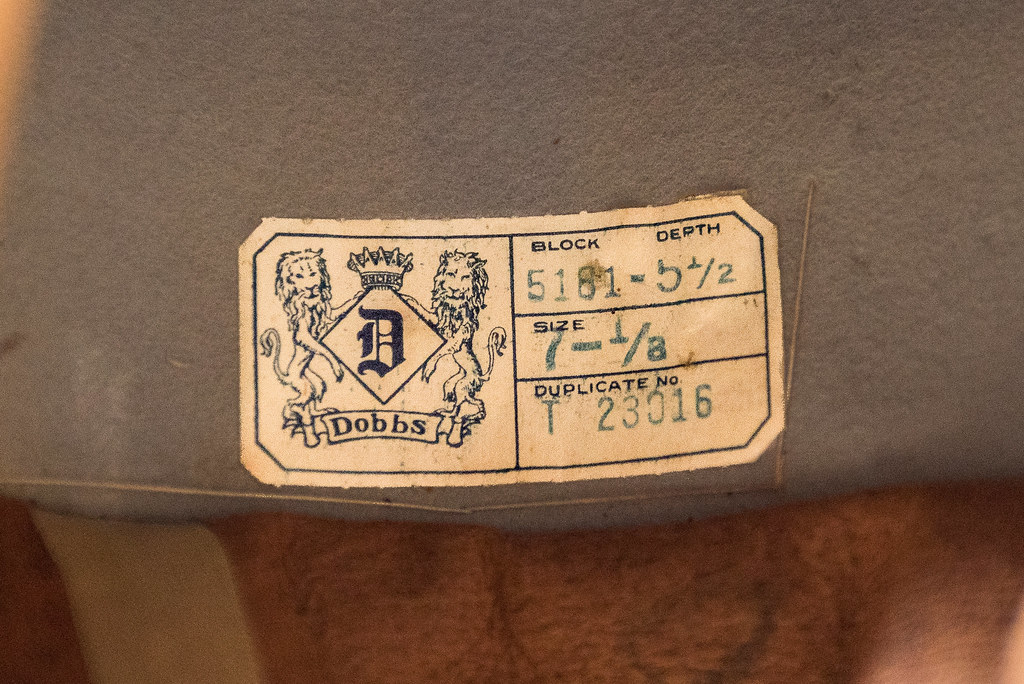
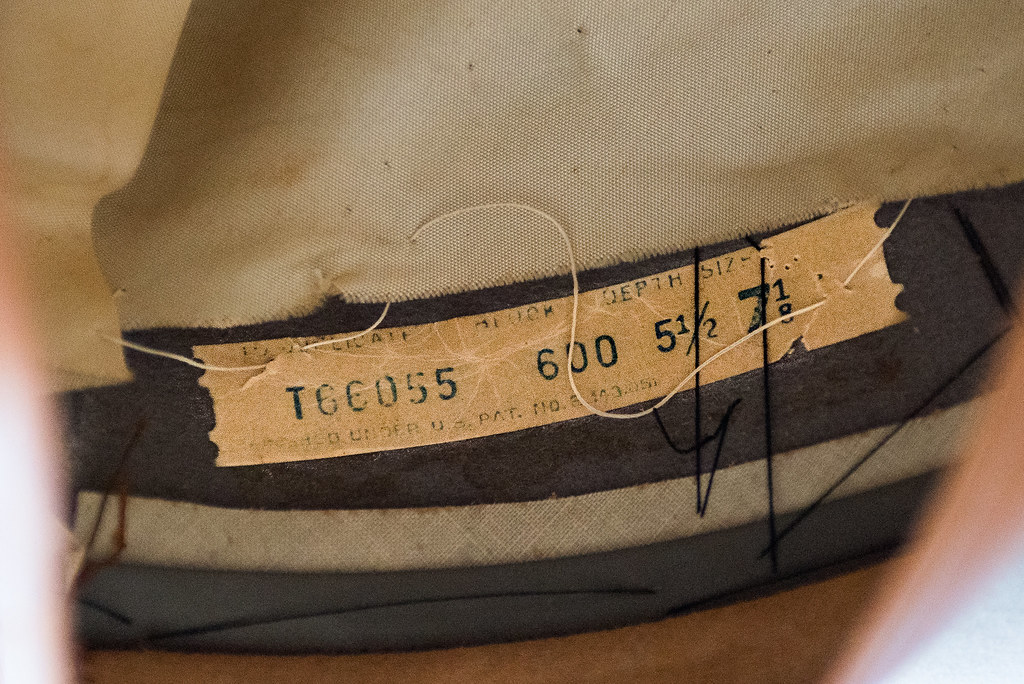
Today, I will be comparing these two examples.
The '30s hat is pale grey with blue/purple undertones depending on lighting, where the '40s De Luxe is grey with what appears to be a slight greenish/blue undertone to the felt.
Side by side, the '40s model seems to be more "blockish" in the crown form, where the '30s has slight reverse taper. From the side, we can see that the 40's has inwards taper, where the '30s maintains a decently straight profile.
The '30s has a raw edge brim treatment, where the '40s has the "Improved Felted Welt Edge", which can be seen in the close up photograph.
The felt to each is extremely smooth to the touch, with the lighter hat being the '30s example (I don't own a scale so I go by the weight in hand). The sweatbands on each are extremely thin, with the '30s being unredded, and the '40s having a reed. The rear seams on the 30s hat is taped, whereas the '40s is stitched together.
Note how hat information labels (behind sweatband) changed within a 10 year span.
















moontheloon
I'll Lock Up
- Messages
- 8,592
- Location
- NJ
beautifully done Justin ... I didn't want it to end
really great
thank you
my OPS era CC is among the lightest and thinnest hats I have ever handled ... just something about these hats
you are lucky to own these ... wonderful examples my friend ... just awesome
really great
thank you
my OPS era CC is among the lightest and thinnest hats I have ever handled ... just something about these hats
you are lucky to own these ... wonderful examples my friend ... just awesome
Featured products
-
 John Lofgren Monkey Boots Shinki Horsebuttt - $1,136 The classic monkey boot silhouette in an incredibly rich Shinki russet horse leather.
John Lofgren Monkey Boots Shinki Horsebuttt - $1,136 The classic monkey boot silhouette in an incredibly rich Shinki russet horse leather. -
 Grant Stone Diesel Boot Dark Olive Chromexcel - $395 Goodyear welted, Horween Chromexcel, classic good looks.
Grant Stone Diesel Boot Dark Olive Chromexcel - $395 Goodyear welted, Horween Chromexcel, classic good looks. -
 Schott 568 Vandals Jacket - $1,250 The classic Perfecto motorcycle jacket, in a very special limited-edition Schott double rider style.
Schott 568 Vandals Jacket - $1,250 The classic Perfecto motorcycle jacket, in a very special limited-edition Schott double rider style.
Outstanding. Thanks for sharing.c.1930s & 1940-45 Dobbs Cross Countries
Today, I will be comparing these two examples.
The '30s hat is pale grey with blue/purple undertones depending on lighting, where the '40s De Luxe is grey with what appears to be a slight greenish/blue undertone to the felt.
Side by side, the '40s model seems to be more "blockish" in the crown form, where the '30s has slight reverse taper. From the side, we can see that the 40's has inwards taper, where the '30s maintains a decently straight profile.
The '30s has a raw edge brim treatment, where the '40s has the "Improved Felted Welt Edge", which can be seen in the close up photograph.
The felt to each is extremely smooth to the touch, with the lighter hat being the '30s example (I don't own a scale so I go by the weight in hand). The sweatbands on each are extremely thin, with the '30s being unredded, and the '40s having a reed. The rear seams on the 30s hat is taped, whereas the '40s is stitched together.
Note how hat information labels (behind sweatband) changed within a 10 year span.
















KarlCrow
One Too Many
- Messages
- 1,719
Fascinating, and amazing hats too.c.1930s & 1940-45 Dobbs Cross Countries
Today, I will be comparing these two examples.
The '30s hat is pale grey with blue/purple undertones depending on lighting, where the '40s De Luxe is grey with what appears to be a slight greenish/blue undertone to the felt.
Side by side, the '40s model seems to be more "blockish" in the crown form, where the '30s has slight reverse taper. From the side, we can see that the 40's has inwards taper, where the '30s maintains a decently straight profile.
The '30s has a raw edge brim treatment, where the '40s has the "Improved Felted Welt Edge", which can be seen in the close up photograph.
The felt to each is extremely smooth to the touch, with the lighter hat being the '30s example (I don't own a scale so I go by the weight in hand). The sweatbands on each are extremely thin, with the '30s being unredded, and the '40s having a reed. The rear seams on the 30s hat is taped, whereas the '40s is stitched together.
Note how hat information labels (behind sweatband) changed within a 10 year span.
















Wonderful comparison, Justin. Thank you.c.1930s & 1940-45 Dobbs Cross Countries
Today, I will be comparing these two examples.
The '30s hat is pale grey with blue/purple undertones depending on lighting, where the '40s De Luxe is grey with what appears to be a slight greenish/blue undertone to the felt.
Side by side, the '40s model seems to be more "blockish" in the crown form, where the '30s has slight reverse taper. From the side, we can see that the 40's has inwards taper, where the '30s maintains a decently straight profile.
The '30s has a raw edge brim treatment, where the '40s has the "Improved Felted Welt Edge", which can be seen in the close up photograph.
The felt to each is extremely smooth to the touch, with the lighter hat being the '30s example (I don't own a scale so I go by the weight in hand). The sweatbands on each are extremely thin, with the '30s being unredded, and the '40s having a reed. The rear seams on the 30s hat is taped, whereas the '40s is stitched together.
Note how hat information labels (behind sweatband) changed within a 10 year span.
















- Messages
- 15,129
- Location
- Buffalo, NY
Great Justin... brings my mind back to the first post on this thread!
splintercellsz
I'll Lock Up
- Messages
- 6,146
- Location
- Somewhere in Time
That it does, Alan! Tough to pick which of yours I like more, as each are spectacular!Great Justin... brings my mind back to the first post on this thread!
Sent from my SM-G935P using Tapatalk
splintercellsz
I'll Lock Up
- Messages
- 6,146
- Location
- Somewhere in Time
No no, thank you!!Wonderful comparison, Justin. Thank you.
Sent from my SM-G935P using Tapatalk
splintercellsz
I'll Lock Up
- Messages
- 6,146
- Location
- Somewhere in Time
Truly, the both are. Each, though sharing the same name, has it's own "personality"Fascinating, and amazing hats too.
Sent from my SM-G935P using Tapatalk
splintercellsz
I'll Lock Up
- Messages
- 6,146
- Location
- Somewhere in Time
Very welcomeOutstanding. Thanks for sharing.
Sent from my SM-G935P using Tapatalk
splintercellsz
I'll Lock Up
- Messages
- 6,146
- Location
- Somewhere in Time
Dobbs knocked it out of the park with the CC platform, didn't they?beautifully done Justin ... I didn't want it to end
really great
thank you
my OPS era CC is among the lightest and thinnest hats I have ever handled ... just something about these hats
you are lucky to own these ... wonderful examples my friend ... just awesome
Sent from my SM-G935P using Tapatalk
Rogera
My Mail is Forwarded Here
- Messages
- 3,365
- Location
- West Texas
Very nice Justin. Two stunning examples of the pinnacle of hat making.c.1930s & 1940-45 Dobbs Cross Countries
Today, I will be comparing these two examples.
The '30s hat is pale grey with blue/purple undertones depending on lighting, where the '40s De Luxe is grey with what appears to be a slight greenish/blue undertone to the felt.
Side by side, the '40s model seems to be more "blockish" in the crown form, where the '30s has slight reverse taper. From the side, we can see that the 40's has inwards taper, where the '30s maintains a decently straight profile.
The '30s has a raw edge brim treatment, where the '40s has the "Improved Felted Welt Edge", which can be seen in the close up photograph.
The felt to each is extremely smooth to the touch, with the lighter hat being the '30s example (I don't own a scale so I go by the weight in hand). The sweatbands on each are extremely thin, with the '30s being unredded, and the '40s having a reed. The rear seams on the 30s hat is taped, whereas the '40s is stitched together.
Note how hat information labels (behind sweatband) changed within a 10 year span.
















- Messages
- 12,384
- Location
- Albany Oregon
This was a great one Justin. I have been enjoying your series of comparisons. I wish I had hats like this to compare.c.1930s & 1940-45 Dobbs Cross Countries
Today, I will be comparing these two examples.
The '30s hat is pale grey with blue/purple undertones depending on lighting, where the '40s De Luxe is grey with what appears to be a slight greenish/blue undertone to the felt.
Side by side, the '40s model seems to be more "blockish" in the crown form, where the '30s has slight reverse taper. From the side, we can see that the 40's has inwards taper, where the '30s maintains a decently straight profile.
The '30s has a raw edge brim treatment, where the '40s has the "Improved Felted Welt Edge", which can be seen in the close up photograph.
The felt to each is extremely smooth to the touch, with the lighter hat being the '30s example (I don't own a scale so I go by the weight in hand). The sweatbands on each are extremely thin, with the '30s being unredded, and the '40s having a reed. The rear seams on the 30s hat is taped, whereas the '40s is stitched together.
Note how hat information labels (behind sweatband) changed within a 10 year span.
















+1Outstanding. Thanks for sharing.
Similar threads
- Replies
- 15
- Views
- 5K
- Replies
- 4
- Views
- 536